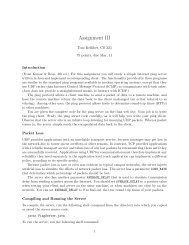Version Control with Subversion - Electrical and Computer ...
Version Control with Subversion - Electrical and Computer ...
Version Control with Subversion - Electrical and Computer ...
You also want an ePaper? Increase the reach of your titles
YUMPU automatically turns print PDFs into web optimized ePapers that Google loves.
Preface<br />
“If C gives you enough rope to hang yourself, think of <strong>Subversion</strong> as a sort of rope storage facility.”<br />
—Brian W. Fitzpatrick<br />
In the world of open-source software, the Concurrent <strong>Version</strong>s System (CVS) has long been the tool of<br />
choice for version control. And rightly so. CVS itself is free software, <strong>and</strong> its non-restrictive modus oper<strong>and</strong>i<br />
<strong>and</strong> support for networked operation—which allow dozens of geographically dispersed programmers<br />
to share their work—fits the collaborative nature of the open-source world very well. CVS <strong>and</strong> its<br />
semi-chaotic development model have become cornerstones of open-source culture.<br />
But like many tools, CVS is starting to show its age. <strong>Subversion</strong> is a relatively new version control system<br />
designed to be the successor to CVS. The designers set out to win the hearts of CVS users in two<br />
ways: by creating an open-source system <strong>with</strong> a design (<strong>and</strong> “look <strong>and</strong> feel”) similar to CVS, <strong>and</strong> by attempting<br />
to fix most of CVS's noticeable flaws. While the result isn't necessarily the next great evolution<br />
in version control design, <strong>Subversion</strong> is very powerful, very usable, <strong>and</strong> very flexible.<br />
This book is written to document the 1.2 series of the <strong>Subversion</strong> version control system. We have made<br />
every attempt to be thorough in our coverage. However, <strong>Subversion</strong> has a thriving <strong>and</strong> energetic development<br />
community, so there are already a number of features <strong>and</strong> improvements planned for future versions<br />
of <strong>Subversion</strong> that may change some of the comm<strong>and</strong>s <strong>and</strong> specific notes in this book.<br />
Audience<br />
This book is written for computer-literate folk who want to use <strong>Subversion</strong> to manage their data. While<br />
<strong>Subversion</strong> runs on a number of different operating systems, its primary user interface is comm<strong>and</strong>-line<br />
based. It is that comm<strong>and</strong>-line tool (svn) which is discussed <strong>and</strong> used in this book. For consistency, the<br />
examples in this book assume the reader is using a Unix-like operating system, <strong>and</strong> is relatively comfortable<br />
<strong>with</strong> Unix <strong>and</strong> comm<strong>and</strong>-line interfaces.<br />
That said, the svn program also runs on non-Unix platforms like Microsoft Windows. With a few minor<br />
exceptions, such as the use of backward slashes (\) instead of forward slashes (/) for path separators,<br />
the input to <strong>and</strong> output from this tool when run on Windows are identical to its Unix counterpart.<br />
However, Windows users may find more success by running the examples inside the Cygwin Unix emulation<br />
environment.<br />
Most readers are probably programmers or system administrators who need to track changes to source<br />
code. This is the most common use for <strong>Subversion</strong>, <strong>and</strong> therefore it is the scenario underlying all of the<br />
book's examples. But <strong>Subversion</strong> can be used to manage changes to any sort of information: images,<br />
music, databases, documentation, <strong>and</strong> so on. To <strong>Subversion</strong>, all data is just data.<br />
While this book is written <strong>with</strong> the assumption that the reader has never used version control, we've also<br />
tried to make it easy for users of CVS to make a painless leap into <strong>Subversion</strong>. Special sidebars may discuss<br />
CVS from time to time, <strong>and</strong> a special appendix summarizes most of the differences between CVS<br />
<strong>and</strong> <strong>Subversion</strong>.<br />
How to Read this Book<br />
This book aims to be useful to people of widely different backgrounds—from people <strong>with</strong> no previous<br />
experience in version control to experienced system administrators. Depending on your own background,<br />
certain chapters may be more or less important to you. The following can be considered a<br />
“recommended reading list” for various types of readers:<br />
xiii










